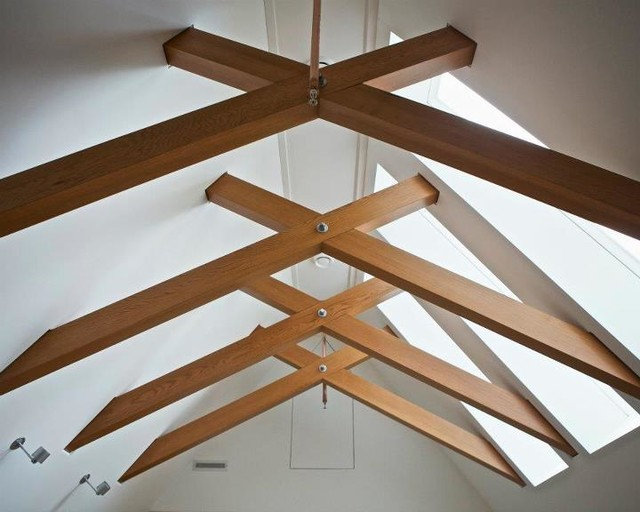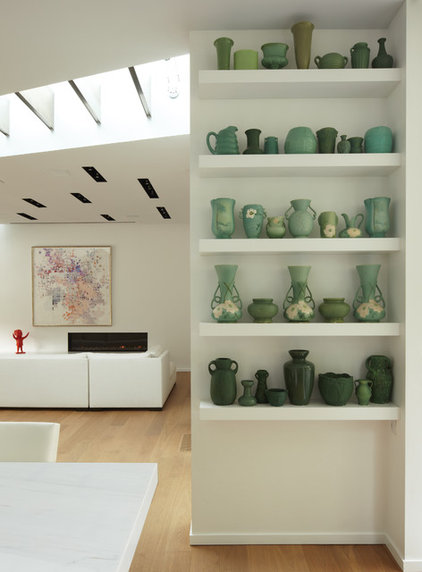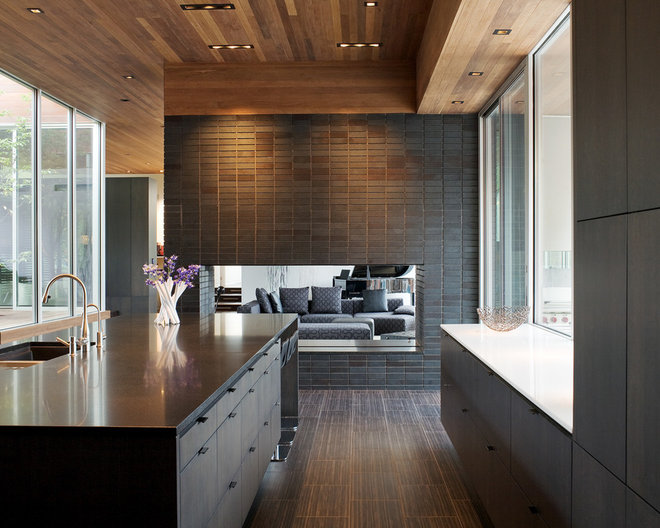Our dominant sense as humans is sight. We’ve evolved a finely tuned
awareness of light levels around us and assigned them meanings — the
warm afternoon sun, a cool and snowy sky, a candlelit table — all of
them connected to human emotion. Architecture invokes light to play on
these emotions, to render the scale and mood of our spaces, and to
create functional places in which to live.
Good lighting designs
balance three primary types of light: ambient, task and accent.
Architects and designers make lighting decisions based on the needs of
individual spaces and how to tip that balance to achieve certain
effects. Here are a few cool tricks worth considering for your next
project.
Hide the light source. Lighting
a space from an unseen vantage point does two things: It emphasizes
architectural form or structure, and it adds mystery and depth,
especially to small spaces. Consider a
skylight, solar tube or
clerestory window to achieve this effect.
This
house has been carved into the site’s topography. The hidden light
source recalls both the weight of the surrounding earth and the change
in elevation from one side to the other. It’s a complex house that never
reveals itself all at once, and the light source complements that idea.
Not
knowing where the light comes from, we instinctively draw our own
conclusions and extend the perception of space to encompass the source
of light outside. It’s a powerful effect.
Employ irregular spacing. Lighting
on a grid is a common approach and makes good sense when even light
levels are required or for working around framing on an interior living
space. But the more whimsical approach shown here conjures movement and
invokes images of a starry sky, twinkling votives or lightning bugs.
Casting
small pools of light in a random pattern encourages informal
circulation and gathering. Take care to use this approach sparingly. In
this example the regular pattern of the lighting in and on the flanking
structures is what makes the irregular pattern stand out. If all the
lighting were irregular, it would appear chaotic and disorderly.
Use dramatic contrast. While
many lighting techniques rely on the even distribution of light, a
theatrical treatment can be useful for creating unique emotional
connections to a place, establishing importance as well as leading
people to a destination.
High levels of contrast in a lighting
scheme allow this technique to work here. The light filtering in from
above promotes a feeling of quiet reverence, seclusion and
contemplation.
Use daylight. When it
comes to lighting a space, natural light always wins. Daylight is
full-spectrum light, composed of roughly equal parts of all wavelengths
(colors) of light. It’s the light our senses are most tuned to, and we
intuitively understand what changes in natural light mean — from weather
to time of day and season. We can use natural light to bright and warm
our rooms, and it’s an abundant free resource.
Locating openings
higher in a wall or roof plane will permit you to admit more natural
light deeper into a space. Always remember that the direction your
windows face will influence the type and coloration of light you’ll
receive. North-facing windows admit an even, diffuse light that’s closer
to the blue end of the light spectrum. South- and west-facing openings
allow large amounts of warmly toned but often high-contrast light.
Knowing this, you can allow for a means of modulating it to prevent
unwanted glare, heat buildup and fade-causing ultraviolet rays.
Consider the rule of three. Most
successful lighting concepts use a combination of three types of
lighting: ambient, task and accent. By layering all three in differing
proportions, you can achieve professional results.
Ambient lighting. The
general illumination in a space is called ambient light. While both
task and accent lighting contribute to ambient lighting, ambient light
sets the predominant light level and mood in a space. In the room here,
most of the ambient light comes from a large wall of glass to the right
(not shown), with some support from the wall washers located in the
ceiling. The mood is sheltering with a steep gradient between the bright
exterior wall and the dimly lit, cooler interior.
Task lighting. The
pendant task lighting above the desk illuminates the work area. While
it contributes to the ambient light, it’s clearly secondary. It also
helps to divide the space for work and the one for repose.
Accent lighting. The
table lamp functions as the accent; it lends a pop to the wall area
nearby but does little for the real work zone in the room. The layering
of it and the other two types allows for both light and dark places in
the room and reinforces the overall interior concept of a cooler refuge
in a desert landscape.
Be bold. Groupings of
multiple fixtures always look better. Don’t be afraid to use a large
number of the same type of fixture. They anchor spaces by defining an
overhead plane and act as a stopping point for the eye. The pool of
light they cast illuminates the horizontal plane below and creates an
implied space. Think in multiples for maximum effect. It shows intent.
Consider the trim. One
often-overlooked detail related to recessed lighting is its appearance
when it isn’t illuminated. Lighting trim, the finished component that
holds the bulb in the housing, can have a strong presence on a ceiling
plane. If your ceiling is white, selecting a darker light trim will
strongly emphasize its geometry. It will also reduce glare from the
light source when lit. Selecting a white trim will tend to blend the
fixtures into a white ceiling plane.
Here the architects
integrated linear troughs into the larger design concept by staggering
the dark trims to complement the structure in the ceiling.
Think custom. Pair any
translucent material with a light source and you’ve created something
uniquely yours. The architects here added a translucent resin panel
embedded with bear grass and added backlighting to create a 35-foot-long
luminous sculpture. The view outdoors commands attention by day, and
the fixture commands it by night.
The inner workings of custom
luminaries can be fabricated from affordable, utilitarian lighting
components and covered in more luxurious finishes. Be sure to include
dimmers in your lighting design; you’ll want control over how much light
emanates from your custom creation.
Light the destination. Light
naturally draws us in and suggests refuge. This concept can be put to
use in any part of a home, but it’s especially effective outside, to
announce entry, establish gathering points and suggest hierarchy among
building components. I really appreciate how the ambient light emanating
from this garage is enough to bridge the gap between arrival and entry
without the need for intermediate path lighting. This further enhances
the destination lighting.
Uplight only. For pathways
and circulation areas, it’s often suitable to provide only enough
ambient light to get from here to there. Uplighting produces a
relatively flat overall light, but washing a textured wall with soft
streaks of light, as shown here, encourages movement and renders the
wall surface an artful composition.
Do the math. Having a hard
time knowing exactly how much light you need in a space? As a rough
guide, calculate the square footage of the space you’re trying to light
and multiply that total by 1.5 to get the total wattage required.
When
selecting CFL (compact fluorescent) or LED (light-emitting diode)
fixtures, be sure to check the lamp’s incandescent-equivalent wattage.
For example, the light output of a 13-watt CFL is equivalent to a
60-watt incandescent. The wattage ratings measure how much electricity
the bulb actually uses, not the amount of light it gives off. If you can
afford it, use
dimmers on every circuit for maximum control of light levels.
It can compensate for overlamping (using a bulb with a too-high wattage for the fixture) as well.
Be square. You’re probably
familiar with traditional round recessed lights, but those are not the
only option anymore. I’m a huge fan of square recessed light trims,
especially when they’re used in places that by nature have square edges,
like this ceiling. The trims fit with the dominant geometry of the
ceiling — no round cutouts to be done. As a whole I think they just feel
more custom.
Square trims have all of the options of their
round counterparts and don’t require any specialized features. Some
lights are even available trimless (with no flanges), for a completely
integrated look.
Light the background. When
the budget is stretched on the interior of a home, it’s hard to think
about the exterior and landscaping. But outdoor lighting is especially
important when your home has living areas with large windows. Remember
at night, from your living areas, any glass walls will appear as dark
planes if care isn’t taken to light the area behind the glass. It
doesn’t have to be much light, just bright enough to see from inside.
Lighting
recessed into overhead soffits can be tightly focused on the ground,
and that’s usually enough to deaden the black-hole effect. Doing this
will also expand your perception and sense of space outward. You’ll be
glad you did.
Bare the bulb. The humble
lightbulb, or lamp, as the lighting professionals refer to it, is worthy
of celebration. Too often we work hard to conceal this essential
component.
While the bare bulb may not be appropriate for every
space, it is in this bathroom. This is a place where lighting one’s face
is essential and the omnidirectional light from the exposed lamp works
well.
Now that legislation has forced the phase-out of
inefficient incandescent bulbs, new emphasis has been placed on
designing CFL bulbs that are aesthetically pleasing. The bulbs shown
here are made by Plumen, in London, and are a wonderfully sculptural
alternative to the more common twisted-spiral CFL.
Consider museum lighting. Think
of your home as a gallery and put specialty museum lighting to work. It
feels unexpected and highly custom. The bulbs are typically halogen,
for lighting that has a sparkle you won’t find with CFL or LED lamps.
Don’t be afraid to use these even if your art collection isn’t what
you’d like it to be. Consider the effect of these fixtures washing a
wall of reclaimed wood or stacked stone.
Lead with light. Here an
embedded linear light draws a line to the home’s entry. Vertical windows
at the corners wash the walls with light, and the interior windows
suggest a welcoming home.
Designers think about the differences
between night and day and how lighting will reveal those differences.
This walkway comes alive at night because of a small, thoughtful
insertion in a simple walkway.
Thinking outside of the normal
bounds of common experience can yield exciting results; with a few
simple gestures, this project offers proof.















